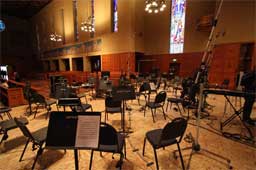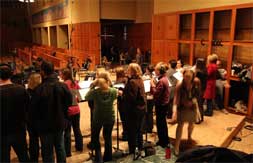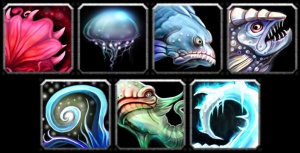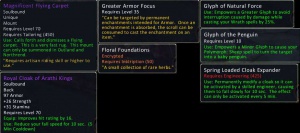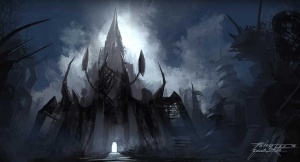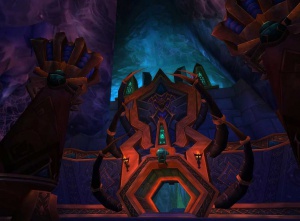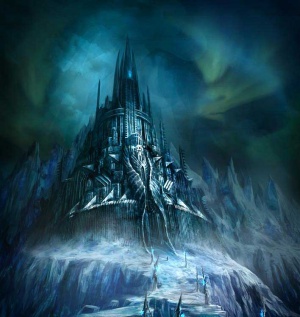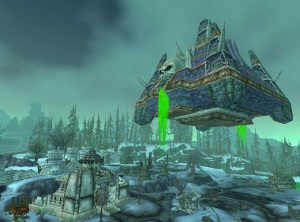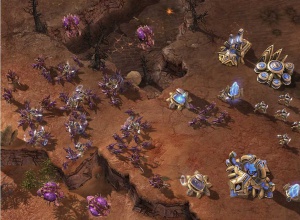BlizzCast Episode 4
When: Episode Four was broadcast on 7th August 2008
Duration: 60:33
Who: Nethaera interviews Russell Brower, Director of Audio and Video. Drysc interviews Jon LeCraft, Profession designer on World of Warcraft. Q&A with Jeff Kaplan, Lead Designer on World of Warcraft. Starcraft 2 Q&A with Mike Heiberg, Senior Game Designer and David Kim, Associate Game Balance Designer.
| Blizzcast Index [e] | |
| Episode 1 | Episode 2 |
| Episode 3 | Episode 4 |
| Episode 5 | Episode 6 |
Contents
Introduction
[00:17]
Nethaera: Welcome to Blizzcast episode 4! This is Nethaera from the World of Warcraft Community Team.
To begin this episode I’ll be interviewing the Director of Audio and Video, Russell Brower, where we discuss the music of World of Warcraft, the inspirations, the journey that has made the music what it is today, and where it’s going in the future. Also in this episode, Drysc sits down with World of Warcraft game designer Jonathan LeCraft to discuss professions both now and in the future. To end this session, we will join Bornakk for the Community Q&A with World of Warcraft Lead Designer Jeff Kaplan, Starcraft II Associate Game Balancing Designer, David Kim, and Senior Designer Mike Heiberg.
Part One - Interview with Russell Brower, Director of Audio and Video
[00:57]
Nethaera: Welcome to BlizzCast Russell!
Russell: Hey, Nethaera! Good to be here.
Nethaera: I’ve been looking forward to this interview with you, and I know many players have wanted to hear more about the processes behind the music in our games.
Russell: Me too!
[01:09]
Nethaera: Could you share with the listeners a bit more about what you do?Russell: Well I feel very lucky because the Sound Department and the Video Department work on every project Blizzard does, so World of Warcraft, Starcraft II, things that are in development, the concerts at BlizzCon the Worldwide Invitational, these podcasts, everything. So, we all wear several hats in this department and so in addition to being the administrator and just keeping all the schedules and planning intact, which I do with a very able staff of producers who without whom I could not even… I just shouldn’t even get out of bed in the morning. In addition to that, it enables me to, as long as they have a tight ship running, I can write music, which is the one thing that I do hands-on here still. There are three of us on staff who write music as much of the time as we can, or full-time, and I’m proud to be one of those folks.
[02:12]
Nethaera: Alright.
Some people may not realize how much music is in World of Warcraft, The Burning Crusade, and even the latest patch. Could you give us an idea of just how much music has been composed for the game overall?Russell: When World of Warcraft shipped in 2004, it had, I would say, just shy of about 2 hours of music. And today, with the recent release of patch 2.4, Fury of the Sunwell, we’re just shy of 16 hours of music in the game. I’m also proud to say that probably two thirds of that feature live players at least in part if not all the way up to full orchestra for many many tracks.
[02:59]
Nethaera: How long does it generally take to create one new piece of music?
Russell: Well, like everything at Blizzard, it takes as long as it takes to be right.
Nethaera: When it's ready.
Russell: When it’s ready. And, it depends on how long something’s been cooking in the oven, if you will. I’ve known about the Fury of the Sunwell concepts now for many many months and so I’ve had the luxury, being on staff here, I’ve had the luxury of mulling this over and looking at the concept art for weeks and weeks. And once a few months ago when I could initially get into the internal server and I could explore the Isle of Quel’Danas and everything like that, I started taking screenshots.
And so a typical experience for me is that I will take hundreds of these screenshots that somehow capture the mood of the space for me. And I’ll put those on my screensaver at work or on my wallpaper or what have you. And as long as I have between then and when I actually have to sit down and start writing, I’ll be mulling that over. And the more time spent doing that, actually the faster the music comes out in the end.
So in the end some pieces may go very fast. I might write a piece of music in an hour or so and some pieces will take longer. I’d say the Black Temple was probably about five days of actually sitting down and writing and Fury of the Sunwell was about three days of sitting down and actually writing. And that was in both cases a similar amount of music, just shy of an hour each.
[04:47]
Nethaera: There’s been a lot of curiosity in regard to the Blood Elf music in light of the latest content update, Fury of the Sunwell as you mentioned. Could you tell us a bit about the evolution of this music and where the inspiration came for the creation of it? You said you did a lot of in game play and everything else, but what else might have inspired?Russell: Well one thing I really appreciate here on all our projects is the backstory and the lore which is behind it all. I mean it’s gameplay first, but it all has context. It all has a reason for being there. So when we first introduced blood elves as a playable race, I went through their backstory and tried to understand what they were all about. What was compelling to me was they were a beautiful race to look at and yet they have just about the most tragic backstory of any of the races. Certainly, they’re right up there.
So, that led to a couple of concepts early on and again, this is pre-release of Burning Crusade. One concept was, I featured a lot of solo cello because that instrument, at least when it’s played a certain way to me can achieve this amazing duality of both gorgeous and melancholy at the same time. So with that in mind, I employed another device, there’s an interval in music known as the tri-tone where if you play a C natural on the piano, the F sharp above would be a tri-tone, and it’s been referred to in history as many things including the devil’s interval and things like that, it’s even been controversial in times. The reason is, it’s not quite consonant and it’s certainly not terribly dissonant and it makes people feel kind of uneasy without being harsh or jarring. So I wrote all around that interval and you’ll hear it in Sunstrider Isle. You’ll hear it in Lament of the Highborne. I’m playing a lot of games with that interval.
So those two devices, that interval and the cello together with kind of tying into the choir ideas that were started with the night elves being a related race, in the original release of the game, that palette of choir and harp and whatnot just all blended together and formed the basis, or vocabulary if you will, for the blood elves. When Fury of the Sunwell came along, this seemed like a great opportunity to sort of bookend that experience. I figure if you happened to have rolled a blood elf and reached the Isle of Quel’Danas as a blood elf, sixty-something levels ago, you last heard this music. And as this music and related new pieces that have evolved start coming back, there’s kind of this connection that I hope players will feel to the original material. There’s a consistency there. I employed a lot of the same singers and whatnot to increase the sense of continuity to the stuff that you may not have heard for weeks or months since you first rolled your character.
[08:21]
Nethaera: What has been your favorite part of the process in creating the music for Fury of the Sunwell?Russell: Well in keeping with the idea of revisiting the thematic ideas from the blood elves, I really enjoyed getting the opportunity to write kind of a companion piece to the Lament of the Highborne which had proven to be such a cool and compelling part of the Burning Crusade experience. This song which is called “Shorel'aran”, which is Thalassian for farewell is, it doesn’t have words it’s just kind of hummed or sung on an ahh, but I had the same singer who had done Lament of the Highborne come in once again and just do a heartfelt rendition of this piece which really does sound like a relative of Lament of the Highborne. You hear it when things are really at its most tragic in the Isle of Quel’Danas as well as in the Sunwell instance.
[09:25]
Nethaera: In Sunwell Plateau.
Russell: Mm Hmm. Exactly. That was probably the most fun, it really felt like on a musical level we had achieved something that I know Chris Metzen and the others who work on the story try to achieve and that is the sense of a continuum that sometimes you see isolated stories and events that are compelling in and of themselves, but then if you take a step back and look at the broader picture, there’s really a lot to this world and it all ties together in ways that are really compelling to explore.
[10:03]
Nethaera: Is there a particular piece that you’ve found to be your favorite either in Fury of the Sunwell or Burning Crusade?
Russell: Well I have to say that if you listen to the Burning Crusade soundtrack there’s a piece called “Shards of the Exodar” which was written by Derek Duke and this is what you hear in the Exodar when you roll a draenei character. It’s something that is so… it’s ambient and because it’s ambient it infiltrates your experience in a way that is not... it’s not as in your face as say the blood elf music or something like that he built it with a series of vocal tones.
He built kind of a tone poem if you will of evolving chords that he did with his own voice using techniques of looping and certain editing techniques and that was overlayed with some really stirring performances on a number of instruments but principle among them an ancient instrument called a duduk which is very emotional. This performer who actually reprised that performance at our BlizzCon show last year just together, he and Derek did this piece live and it was amazing it actually got a standing ovation because there was this one moment that was so emotional. This player has done the duduk and other wind ethnic wind solos for many big major picture films and he’s just the best and we’re so lucky to have gotten to work with him.
Nethaera: That was a fabulous event.
I have heard that there is new opening screen music in the works for World of Warcraft’s second expansion Wrath of the Lich King. Even though this is still a work in progress, would you mind giving everyone a preview of it?
Russell: I would really enjoy playing some of this for you and the watch word is “work in progress” because as we record this interview it’s only been two days since I was on the orchestra stage so I haven’t added in the big epic drums and the other things that really add to the Warcraft vocabulary that hopefully is becoming quite recognizable in context with World of Warcraft.
[12:36]
Music Plays
[13:27]
Russell: So what this is, I’ve taken the march that’s in 7:4 that’s been in both versions of the login screen music to date and re-envisioned it once again, this time I’m going a little more primal. The first version was very dark and had a timbre that was mostly achieved with synthesizers, but definitely had a strong mood of something brewing. And then the second version for Burning Crusade was for one thing, a live orchestra but was also filled out in a completely different way. It was a little more like an overture as opposed to a piece of film score. So I wanted to find with the version for Wrath of the Lich King something in between that echoed of really classic fantasy film scores but would bring to bear the power of the 96 piece orchestra that we had and 90 voices that we had in the choir.
My thought process behind choosing the sections of the login screen music were that we should have something old and something new and visit all of the releases of World of Warcraft. So there are pieces from the initial release in 2004 kind of re-imagined or revisited, rearranged into something that you might not expect. There are a few quotations from Burning Crusade as well as some of the patches like Black Temple and Fury of the Sunwell. And then there are some themes from Wrath of the Lich King. These are all part of the World of Warcraft so over a course of seven plus minutes instead of, we’re up from four in Burning Crusade, the orchestra and this wonderful choir take you on this little journey through places you may remember or that you have yet to encounter that you have yet to enjoy and hopefully shed a little light on what’s in store for you in Wrath of the Lich King.
Nethaera: So it’s very much a musical chronicle.
Russell: Yes, and I hope to certainly update it with each major expansion, much as we’ve done now.
[16:01]
Nethaera: Is there a particular sound you’re planning to weave into the expansion? With the Burning Crusade, there seems to be a lot of orchestral and choral music that has been used to set the mood. The setting for Wrath of the Lich King seems to imply that there are a lot of opportunities for you to continue the evolution of the score.Russell: Well first off the decision to add more live players and more orchestras and choirs in to a great extent is because I want this stuff to be timeless much like everything else of what we do is timeless, the gameplay, and the backstory, and everything. And the more that we have organic human performances doing this music, I think the longer that it will last and the more that it will resonate with people.
So that’s part of the reason, but another thing we do is want to expand the vocabulary. So, while you think of having a lot of French Horns for instance as the quote unquote Warcraft sound, in Wrath of the Lich King we’re experimenting with some other things to convey the harshness of Northrend. The whole continent isn’t covered with snow by any means but it is a cold, challenging environment, and we’re looking for ways to express even more about the environment around you through the music.
One of the things we’re experimenting with is something called prepared piano. This is where you play a piano but not with the keys, you open it up, you take the lid off and you rub the strings or hit the strings with various objects and things like that and you get tonal unique sounds that are at once kinda creepy and unnerving and yet strangely musical and that’s one of the many things that we’re playing with.
There’s also some pretty cool ways to use a choir as a special effect, not just singing out loud with big vowel sounds or singing in Thalassian or whatnot. There are things that the choir can do with their voices with little dissonances and special effects and gliding chords… And you’ll hear a little bit of that in the login screen music as well. All of these things can convey a sense of cold and foreboding and adventures yet to come.
[18:35]
Nethaera: I’d like to thank Russell for taking the time to talk with us today. I know the Community Team and everyone else at Blizzard is looking forward to the new audio we’ll be experiencing in the expansion and would like to thank the entire sound department for their amazing work. This is Nethaera from the World of Warcraft Community team, signing off for now!
Part Two - Interview with Jon LeCraft, Profession designer on World of Warcraft
[19:05]
Drysc: Welcome everybody to the World of Warcraft portion of this BlizzCast. This is Drysc from the Community Team, and today we’re sitting down with the Profession designer for World of Warcraft – the ironically named Jon LeCraft. How’s it going Jon?
Jon LeCraft: It’s going great.
Drysc: I think everybody that plays WoW has an idea of what professions are, but what is a profession designer actually in charge of doing on the project?
Jon LeCraft: I don’t think it’s any secret that I do all the profession stuff. Everything from cooking to tailoring, and that involves when new recipes are added, or they’re changed. And even down to the daily quests for cooking and fishing, and hopefully some more as we add them in the future.
[19:50]
Drysc: With Burning Crusade we saw some fairly dramatic changes as opposed to the original game. Some new trade good synergies, some differences in how the professions were used for filling out your item slots. How is that design philosophy going as we move into Lich King, and what did we learn from that?
Jon LeCraft: We’re definitely happy with how people are excited about tradeskills they weren’t before. They definitely had some big improvements, things like blacksmithing, and tailoring, and leatherworking, all of a sudden were really exciting. There are some issues with that, the whole best in slot, y’know “Oh, hey I have an awesome mace” but then you know, the guy goes raiding and replaces it. So, in addition to that we’re moving toward some perks, so to say… like, I’ll give you an example that we’re thinking about doing, is that Blacksmiths would be able to add sockets to a weapon, or Armorsmiths would be able to add a metasocket to armor. So, that kind of thing.
[20:52]
Drysc: Yeah this would be any item that you pick up. We're definitely going to have the Bind on Pickup items that you get and require nethers or something like that or a whole bunch of reagents to give you a jump start in that category. Once you're done with that item or you just decide to do something else we still want you to be getting something out of the trade skill.
Jon LeCraft: Yeah this would be any item that you pick up. We’re definitely going to have the Bind on Pickup items that you get and require nethers or something like that or a whole bunch of reagents to give you a jump start in that category. Once you’re done with that item or you just decide to do something else we still want you to be getting something out of the trade skill.
Drysc: Ok, so it’s a new high end sort of “ring enchant” kind of a thing, where you have something specific to what you can do to your items?
Jon LeCraft: Yeah, definitely.
[21:35]
Drysc: Let’s go ahead and jump into specific points for every profession we can hit in the time we have. Let’s start with, Tailoring. So with Tailoring we had the Frozen Shadoweave set which was kind of a problem early on, maybe still a problem, it’s very powerful obviously. What did we learn, maybe from that slot, with the Frozen Shadoweave set, and how are we taking that into the Lich King expansion?
Jon LeCraft: Well, Frozen Shadoweave suffered from some interesting problems – and I say that with quotes even though you can’t see them – in that it was over optimized. It used school damage, which generally you get a lot more points out of that, and the sockets were extremely well done. So it ended up being so DPS oriented that people would compare just the DPS portion to all these other tiers, because that’s all they cared about. And it was just vastly superior, so … and that was partially in reaction to Tailoring not being very good before Burning Crusade, and just really wanting to make it awesome, but we definitely overstepped the boundaries a little bit there and we’ll just be more careful in the future. Also, that stuff didn’t require any Nethers, so a lot of people would just go “Oh, well, you know I can just kind of pay for my way up to get that one” which is cool, and I’m not sure that everything’s going to necessarily going to take a Nether for the bind up pickup in Lich King, we like some of the crafting skills to be different from one another, but that also contributed to the overall issue.
Drysc: when you say Nether you’re referring to something Lich King specific, not necessarily...
Jon LeCraft: Right, we’re not going to be using Primal Nethers in Lich King.
[23:15]
Drysc: *laughs* Ok just making sure. Moving along, and we have Engineering up next. I think one of the larger issues is that people have a lot of expectations about what Engineering should do for them. Some people want it for the PvP aspect, some people just want it for the cool fun toy aspect, some people want it to be able to help other people in their group, stuff like that. What did we learn, and how is that translating into Lich King, once again?
Jon LeCraft:Well what we learned is that we probably nerfed it a little too hard in reaction to what it was like pre-Burning Crusade, where you felt like you had to have it to be competitive in a lot of situations. Especially before Arenas, where Battlegrounds were the thing.
Drysc: Right, Rocket Boots and Parachute Cloaks...
Jon LeCraft: Uh huh, all that stuff… well that stuff still works, but the stuff that we did break like the Mind Control Helmet and everything. We’ll probably end up un-nerfing some of that, or adding in upgrades. Another cool thing we’re doing for Engineering is instead of getting Rocket Boots you’re going to just enchant your boots to become Rocket Boots. So you don’t suffer from this whole “Well I have to use a blue item, to get this cool effect.” Basically we have the tech to add on-use enchantments to things now, so, we’re going to be really running with that. Things like a Parachute Cloak enchant, or maybe you could shoot webs from your gloves, but there’s a little bit of a tradeoff too because that’s still your primary enchant on that item. If you put Rocket Boots on your boots you won’t be able to get the move speed or anything.
Drysc: So a lot of the higher end stuff we’re going probably more with, as you said with Blacksmithing and Tailoring, being able to… I guess “edit” your higher end items with an enchant specific to your profession.
Jon LeCraft: Yes, definitely. And, I just want to say with Engineering you know; also we’re going to try do a bunch of silly stuff too. I mean that’s pretty much a primary objective on Engineering.
[25:17]
Drysc: Yeah of course. So, next we have Blacksmithing. Which you kind of tied into Tailoring a little bit, but one of the obvious potential issues is balancing the specializations: Armorsmithing and Weaponsmithing. Is that an issue that you agree with, and is that the only issue, and how is that being looked at?
Jon LeCraft: I think it’s one of our biggest challenges right now is trying to make people interested in Armorsmithing versus Weaponsmithing. Because the weapon is just so sexy… it’s just so much of your character. Even with the slots thing, I know I mentioned earlier “Oh, well you know if we’re going to add sockets to items like weapons we’ll probably get a regular socket, but the Armorsmith will be able to add a metasocket,” Which is, you know, substantially different. So, if you … don’t really want the weapon you might lean towards Armorsmith… but, again, that’s actually almost the opposite problem where everyone might end up being an Armorsmith, so it’s going to be a difficult balance. We’re still iterating on that one.
[26:23]
Drysc: Moving on, we having Fishing. I think in theory it appeals to a lot of players, but do you have any thoughts on the profession and where it could be headed?Jon LeCraft: Yeah, we’ve definitely had a lot of brainstorming on Fishing lately. And I should also add that I love fishing. I have two 375 Fishing characters...
Drysc: So you’re insane...
Jon LeCraft: ...and I’ve won the tournament multiple times. Yeah, I’m crazy, but I definitely have a lot of love for fishing and want to do a lot of cool things for it. I think the biggest thing right now is going to be the mechanic. It still isn’t… it’s just not that fun, and we really want the act of fishing to be fun. Because the fun part of fishing right now is the, kind of the exploratory part of “Oh, what fish can I catch here, what weird thing can I catch?”, and we definitely want to continue with that but we don’t want the mechanic to be quite as ... I don’t know, you’re just not very attentative while you’re doing it.
Drysc: Personally I kind of watch a movie while I’m fishing, and I turn the sound up and listen for the little bobber sound, and right click ... it’s not necessarily “fun” but also kind of… I can auto-pilot it a little bit.
Jon LeCraft: Yeah, relaxing but I think more interactive is going to be the way to go. Also something that happened and worked out really well in Burning Crusade is the unique fish that cook into the types of food you can’t get anywhere else. The Golden Darters and the Spicy Crawdads, those really helped keep fishing relevant. We’ll do some more of those, although maybe not to that extreme of a swing.
[28:11]
Drysc: Moving on to Enchanting, it’s a useful profession obviously, especially for… I guess it’s considered a sort of “hardcore” profession, more so than the other ones. But I guess similar questions from the previous ones, what have we learned for Enchanting and how are we changing it for Wrath of the Lich King?
Jon LeCraft: Well it is a hardcore tradeskill and it will remain that to some degree. It’s always been one of the more difficult ones, and we kind of like that about it. But going in to Lich King… I think the biggest the biggest problem with Enchanting right now is trying to make money with it, because you can’t make money when you’re offline - with Enchanting. I guess you can through the Enchanting mats, but that’s not very… I mean anybody can really do that, it doesn’t really feel like you’re making use of the skill. So one thing that we’re talking about, and I think I mentioned this at BlizzCon, but we kind of want to make this Enchanting “sponge” type thing. So whereas you would normally enchant your weapon you would enchant this “sponge” and it would kind of absorb the enchant and then the next person could just use that to enchant their weapon. So you could throw that up on the auction house...
Drysc: Squeeze the “enchantin’ juices” out of the sponge…
Jon LeCraft: Yeah, we might hrm... we might go ahead and come up with a more epic name than “Enchanting Sponge”
[29:29]
Drysc: *laughs* Enchanting Sponge sounds pretty good though. So, ok I think you did mention that at BlizzCon but it’s still good to hear about. Let’s move on to Alchemy. So we have the discovery system with Alchemy, which was I think – extremely – popular with Alchemists? If I can say that.
Jon LeCraft: *laughs*
Drysc: How did that work out, and how are we changing that or taking that sort of discovery approach into Wrath of the Lich King, if at all?
Jon LeCraft: Well let me start by saying that the discovery system was intended to help differentiate one alchemist from another, so that they’re able to sell that particular item, because they’re one of the few people that can make it. Which is something we’ve always tried to do with every tradeskill. Unfortunately, it ended up being very frustrating because people didn’t feel like they had any control, and instead of just accepting that they were like “Ok fine, I’m going to just go make 10,000 potions” or whatever, and still wouldn’t get a discovery or didn’t get the discovery they wanted, and that just felt bad. Ok, recipe distribution aside, the discovery system I still think has potential - for fun stuff. You know “Oh hey, I discovered the Elixir of the Searching Eye” rather than that being on a rep vendor or whatever, you know just the cool stuff. Also it worked out pretty well for the Cauldrons, you know you would make probably like five of those resist potions and then all of a sudden you’d discover the cauldron and you’d kind of be done with the last one. So for fairly deterministic upgrades they’re ok, or for the fun stuff, and there might even be some other uses that we haven’t really thought of that are going to fit well with that unpredictability.
Drysc: And do you see that maybe branching out to other professions somewhat? The discovery type systems?
Jon LeCraft: Yeah, definitely. I think we’re going to try that with a few of the other ones, but in the format that I just talked about, where it’s either predictable or just fun stuff.
[31:37]
Drysc: Sounds cool. Jewelcrafting, new in Burning Crusade. Very useful. I think there were some issues with recipe acquisition from reputation vendors, stuff like that, pretty minor I believe. But how did that work out in your eyes, and again what are Jewelcrafters going to be looking forward to?
Jon LeCraft: Well I think to some degree it worked out pretty well, because if you go and look on the Auction House the price of cut gems are more valuable than raw gems. Which is not the case in a lot of the other parts of professions. Where you’ll see the materials are actually the most expensive part, especially when they’re used by multiple professions. We like how that worked out but it still has that level of frustration where you can’t go farm for any of these drops. The reputations are actually really good, it gives you a goal. You have a way to get it, but a world drop you don’t have any control over. So we’re going to be easing off the world drops, I’m not sure about getting rid of them entirely but moving on to other systems. One of the system we’re considering as well is – so you have profession dailies for all of your professions, and what those end up being I’m not sure, but then when you do that daily you get a token. Then on this vendor there’s maybe 20 recipes, and they cost [maybe] 25 tokens each. So you’ll start making decisions on how you want to spend those tokens and that will help differentiate you from everyone else just by your decisions rather than what you happened to have found or bought off the Auction House.
Drysc: Ok, so I took a month and a half to do all my dailies more or less every day, turn in my tokens, possibly get a recipe that the other person in my guild doesn’t have that same recipe, we can of “min/max” our recipe acquisitions that way.
Jon LeCraft: Yeah, totally.
[33:39]
Drysc: Sound very cool. Ok, let’s move on to Leatherworking. We added some cool stuff in 2.3, obviously, drums and such. But same question as all the previous, how did it go in Burning Crusade and where’s it going for Lich King.
Jon LeCraft: Leatherworking was off to a rough start, because the drums were in a place where we were probably too conservative. You know, they were on very difficult reps, they had Primals in the reagents, and you know didn’t really match up with the power that you got from them. And once we brought them to where we wanted to in 2.3, I think it helped a lot. It helped with the leveling definitely, where you’re making something that you can consume and that you’re using a lot rather than these just esoteric items that somebody may or may not want. So I think that worked out pretty well. Another thing that was a little weird about Leatherworking, and this is the same thing with Tailoring, is that they required you to max out the skill to get your bind on pickup item. Like the Primalstrike and whatnot. And that just felt a little too punishing. We’ll probably… like 350 is around, you know to give it in terms of Burning Crusade, is where we’re more comfortable with that. Kind of like we did with the Engineering goggles and things like that.
Drysc: Right, making your best in slot not quite so “I have to get to 375 before I can do anything cool.”
Jon LeCraft: Yeah cause 375 is really, the best use of that is “Oh ok well, I hit 375 so I have recipes I can make money off of.” And that’s the cleaner design there I think.
[35:28]
Drysc: And we’re on to, what could be considered the new profession in Lich King, which would be Inscription, which I know - still under heavy design - but is there anything you can share with us about Inscriptions? And maybe how that’s changed since our announcement at BlizzCon, since I know a lot of people heard about it from the… probably watched it on YouTube, or they were actually there, watched you up on stage talking about Inscriptions. So, how’s that going?Jon LeCraft: It’s actually going really well. We’re getting happier and happier with the design every day, I mean to the point where I can certainly talk about it. So the whole “enchanting your spells” or whatever, we’re still going forward with that. We want it to feel different than Enchanting, so a lot of the effects are pretty epic. We’re not adding knockback to Fireball, like the example we gave. But not only do they have a lot more punch to them, one inscription is probably worth like one to two talent points, and they’re not all just increasing power, sometime they’re a big power increase but they’ll change something else about the spell. Like, going back to Pyroblast because it’s so easy, is we might reduce the cast time down to 3sec but add a 25sec cooldown. You know, the guy that uses that is like “Oh, well I use Pyroblast a lot for soloing, so it’s really handy there” or you know, that’s just a good example of the whole, either increase the power or decrease the cooldown, or even the opposite. Like Last Stand, we might decrease the effect from 30% to 20% of your max health, but give it like a 2min cooldown instead of an 8min cooldown. So those are some of the swings, and it’ll change how you use a spell effectively. And we will be affecting… obviously I gave the Pyroblast example but we’re going to be doing talents, you know it’ll affect talents and stuff. Probably not effecting passive talents very often.
[37:37]
Drysc: How many spells do you see the profession actually affecting? Would it be, every ability for every class, or you know 25% of their abilities?
Jon LeCraft: You know that’s a good question. Definitely not every *laughs* you know I don’t even have time to do every ability in every class, but some of them just don’t end up being very interesting. Like I don’t know what type of inscription I would give to Teleport: Shattrath. Sorry about all the Mage examples, I’ve been working on that one recently so they’re fresh in my mind. But yeah, I’ve been hand picking the ones that are most interesting to affect. It’s probably going to be 15-20 per class, and some of them will have more than one.
Drysc: So about 15-20?
Jon LeCraft: Yeah, around there.
[38:28]
Drysc: Ok, sounds good. I think that about wraps it up. Hopefully we’ll be looking forward to more information about Inscriptions coming up as we get closer to Lich King launch. So I want to thank Jon LeCraft for coming in today, and speaking with us. This is Drysc, signing off, for our World of Warcraft portion of BlizzCast.
Jon LeCraft: Thank you.
Part Three - Q&A with Jeff Kaplan, Lead Designer on World of Warcraft
[39:02]
Bornakk: Hello this is Bornakk from the World of Warcraft Community Team and welcome to another Q&A session of BlizzCast. This set of World of Warcraft questions were emailed directly to us from our players and they will be answered by our Lead Designer Jeff Kaplan.Our first question is from Aztoreth on the realm Kel'thuzad - How long does it take, the whole process, from concept to completion, to create a content patch? This can include testing time as well, and what kind of work goes into bug-fixes while the PTR's are up?
Jeff Kaplan: It takes a really long time. So, the question sort of asks from concept, if the question is from concept it takes years. To put it in perspective the Black Temple, the Sunwell Plateau, and Zul’Aman were all conceived as part of The Burning Crusade. We knew that we were going to have to do content patches for The Burning Crusade and we came up with a list of places that we thought would be acceptable to be patches to The Burning Crusade. So even in the initial concept of The Burning Crusade zone list we had Sunwell on there as you know, Patch 2.4 we’re going to do Sunwell and we’ll get to it eventually. So the idea is around for a long time, that doesn’t mean that the zone is in production for all that time though. Usually for a zone to get in production it takes multiple months of art time simply to construct the art around the asset in the case of the Sunwell, but it also takes anywhere from one to three months to actually do a lot of the design work as well and that ranges from placing the creatures, scripting the abilities, designing the boss fights, itemizing the dungeon, tuning the abilities.
And as far as PTR goes it sort of depends on the level of content. The more hardcore the content is, like if it’s a 25 person raid dungeon, we like to have somewhere in the range of four to six weeks on the PTR. And that gives us enough time to iterate and tune around the most hardcore raiding guilds who show up on the PTR. We watch them, we follow them, we watch everybody on the PTR and go through iteration cycles. On something that’s smaller like a 10 person dungeon or a five person dungeon, we can iterate more quickly internally and have to rely on the PTR much less. So we don’t really demand four to six weeks for a 10 person dungeon although if we need that time on the PTR for other reasons we are more than happy to take it. It’s usually a multi-month project but from concept it’s actually years.To give an example for Wrath of the Lich King, we already know what the patches are going to be, we’ve already come up with them, and have complete plans for how all the patches are going to play out. Really Wrath of the Lich King ends with the final patch that’s where the final culmination, interaction with Arthas, that’s when Icecrown comes in, it’s not the day that Wrath of the Lich King ships, it’s part of that subscription cycle and getting people new content over time.
[42:14]
Bornakk: The next question is from Fehlsharpeye of the BrotherHood guild on Turalyon - The Burning Crusade introduced a number of changes through the patch cycle, some examples are Badges of Justice being included in more dungeons, attunements being removed, and heroic keys becoming easier to get. To what extent is the experience of these changes in The Burning Crusade influencing the development and design of Wrath of the Lich King?
Jeff Kaplan: Well that’s a great question because there’s a huge influence that’s going on there. What you’re seeing are a lot of lessons that we learned. I don’t think a lot of those attunements or the early badge implementation were necessarily wrong. WoW is an evolving game and the players are evolving and the way we make content is evolving and I think we made a lot of decisions right. I think heroics keys being available at revered reputation when The Burning Crusade shipped worked really well, everybody was doing the dungeons together, getting into a pick-up-group to get your own reputation up to revered was a trivial task if you caught the leveling wave when Burning Crusade shipped. The problem happened months later when sort of the population curve had evened out and all that you had were either twinks or new players who didn’t have as much experience and suddenly those players couldn’t get the groups that they needed to progress whether it be heroics or getting attuned to dungeons to catch up to whatever raid guilds they were at.
We’d really like to, rather than be in the situation of retroactively patching adjustments to things like adding badges to guys, removing attunements, or changing the requirements on something like the heroic keys, we’d rather take those lessons into Lich King and go, “Why did those things happen?”, “Could we construct a system where things sort of naturally ease themselves out over time?” And we think we can. We have some ideas how we’d like to handle content in the future, we’d like to do more dynamic events where things open up over time or open up based on the server contribution. We’d also like to make sure that we’re putting players through epic cool story lines to teach them about dungeons with their first character but maybe not forcing them when it comes to their alts or that sort of thing from doing that sort of content. So we have a lot of ideas and we’ve definitely learned a lot of lessons from Burning Crusade and I can’t say that we won’t perhaps make new mistakes but I hope that the patch cycle in Burning Crusade proved that we listened to what players ask for and try to adjust and make the game better with each patch.
[45:09]
Bornakk: Some players felt that The Burning Crusade seemed to create something of a discontinuity in game progression. Is there a goal for the next expansion to be a little less jarring to raiding guilds and players?Jeff Kaplan: Yeah definitely, my analysis of that question would be that first of all there was a change from 40 to 25 and we’re not doing a drastic change like that going from The Burning Crusade to Wrath of the Lich King, there will still be 25 person content. It’s not like we’re adding a new number in there like 15 or 35 or something like that to mess with players. So I think that’s sort of the first part of the question, there’s nothing like that happening so that shouldn’t be jarring to guilds.
The second part of the question in my interpretation of it could refer to what guilds had to do to get into 25 person content which was go through the Karazhan dungeon to get attuned to eventually do the 25 person content. I think we definitely learned from that one and we’re going to make it so that if you’re a 25 person raiding guild right now in Burning Crusade and you go into Wrath of the Lich King, short of leveling up and doing whatever 5 person content you do with your group to level up and get geared up, we’re going to let you go right away into the 25 person content - we’re not forcing you through the 10 person content. Now with that said I think it’s a player misconception that there is this thing that exists only a 25 person raider and that person has no interest in 10 person raiding. I have a feeling many of the 25 person raiders will be engaging in the 10 person content and they’ll actually really enjoy it but they’ll be relieved to know we’re not going to force them through it by no means.
Bornakk: Well, thanks for your help again Jeff!
Jeff Kaplan: Great, thanks for having me here.
Part Four - Q&A with Mike Heiberg, Senior Game Designer on StarCraft II and David Kim, Associate Game Balance Designer on StarCraft II
[47:04]
Bornakk: Up next we have some Starcraft II questions, to help answer them in their first appearance on BlizzCast we our Associate Game Balance Designer David Kim and one of our Senior Game Designers Mike Heiberg here to help us. Welcome to BlizzCast guys!
Mike Heiberg: Thank you.
David Kim: Thanks.
[47:20]
Bornakk: The first question is from D10 at teamliquid.net – What is the reason for the decreased mineral collection by workers? (It goes from 8 to 6 per round.) Is it better worker A.I. or a more economy heavy game maybe?
Mike Heiberg: The harvest rates for classic and Starcraft II are basically the same -
David Kim: It feels faster though, the minerals anyway.
Mike Heiberg: It feels faster at certain points, certainly more so mid to late game but it kind of depends on the race and the expansions and stuff. I think that’s a matter of when you cap out on three per mineral field, just how much income you get versus – like in Starcraft a lot of times you get up to like two per mineral field and you couldn’t quite tell if you were capped out or not because there’s a lot of guys moving around and a lot of times you have an empty mineral field for a few seconds here and there.
When we did the original Starcraft harvesting numbers they were just pulling back way too much minerals because the units path so much better and they don’t do the strange harvesting A.I. that classic Starcraft did. But yeah, that’s why when we put in the original numbers they were harvesting way too fast and we had to take it down a notch. We first tried – we tried a lot of things – we tried bringing their movement speed down, then we had a lot of problems, with an SCV moves slower that means you can’t scout as quickly right, you can’t run away from certain threats, you can’t like dance around and avoid a zealot anymore. You know same thing with some of the other slower units but we tried other things like the acceleration, tweaking how fast they accelerate and decelerate, that got really tricky with how good the unit feels when you’re moving him around. So then we tried how much time they spend at the mineral field, which is actually still in there, right now a unit will bring back 6 per trip instead of 8, but at the same time he will spend a little less time at the mineral field. So overall the amount of time that he spends going back and forth he comes out to about the same harvesting rate as a single SCV in the original Starcraft.
Overall we’re trying to make the feel of the harvesting about the same as it was in classic Starcraft where you really have to think about how much money you have and the minerals-gas ratio and what you can afford to do. How do you think it’s feeling for the whole?
[50:03]
Bornakk: Yeah- does this affect overall units and how they move? I’ve heard the pathing for StarCraft II has been much improved since the original StarCraft.David Kim: Okay the pathing is actually pretty interesting because a lot of the tier 1 units, especially the zerglings and the zealots perform a lot better because they can get into places easier.
Mike Heiberg: We have tried to tweak some of the interaction of some of the earlier units with respect to pathing and create a lot of interesting gameplay with not just the types of units that you’re mashing together but the ways that they’re meeting each other on the battlefield. Where in classic Starcraft you could throw a couple zealots on your choke and zerglings coming in would have a hard time getting past them just because you can only fit so many zerglings up against the zealots right? Now you have a similar thing but at the same time out in the field if you have zealots versus zerglings the zealots have trouble because the zerglings wrap around them, start devouring them. Sometimes it helps to even back up your zealots against a wall or a cliff edge and reduce the amount of wrap around that the zerglings can pull off.
David Kim: Yeah and the wrap around itself is a little easier to pull off I guess because the A.I. takes care of some of that for you but you do still need the micro if you want to get the maximum out of your melee units.
Mike Heiberg: Yeah the pathing of zerglings, will instead of just going around and finding some place they can fit on the other side of the zealot they’ll actually try and nudge up a little closer to the other zerglings so they can fit more of them in which is just kind of something that we got with the updated pathing.
David Kim: We also have the difference in deceleration. In our game the unit knows when it’s going to stop so it starts decelerating at the exact right moment so that it stops at the exact spot that it’s ordered to go to. Whereas in the original it didn’t check as frequently so even if you told it to go somewhere it might stop a half an inch past it or a half an inch before it.
Mike Heiberg: Right, a lot of times you’d be floating your guardians in to take out some spore colony or something and they’d float a little too close and you’d be like “Whoa!” and you’d have to back a couple of them out. They’re a little more intelligent now about not floating directly into danger when they don’t have to.
David Kim: So all in all you can give more precise orders and the units will do exactly what you want to instead of just doing whatever they wanted.
Bornakk: It will be a little more consistent?
David Kim: Yeah it will be more consistent.
Mike Heiberg: Yeah for a game like Starcraft we really want a lot of consistency in how units behave when you tell them to do something because you know this is a game that we hope to be played at a very pro level where people want very precise control over everything that their units are doing. I tell a guy to go there he should go exactly there, I tell a guy to attack over there, he should attack to exactly that point and not roughly what I was telling him to do. So basically trying to fine tune the behavior that you get what you expect out of the unit when you tell him to do something is definitely one of our goals.
[53:36]
Bornakk: How do the three races feel right now in terms of their resource consumptions in relation to the more popular strategies seen here at Blizzard?
David Kim: Resource-wise the three races feel pretty similar. Terrans usually have to mix in mineral-only units such as marines or jackals with their army and with Zerg you can do the same sort of stuff you could do in the original just like fast mutalisks, or fast lurkers, but on top of that we also have interesting strategies, like surprise strategies, such as going fast banelings.
Mike Heiberg: Yeah and you know the other races like reapers and banshees and whatnot, but yeah it’s really a tough decision in the early game to choose how you want to spend your gas, do you want to go to one of the rush strategies? Do you want to tech up to the higher stuff that’s more stable? Or do you want to focus on upgrades and pushing with low tier units? Until you expand you really have to choose what kind of options you want to pick from.
David Kim: And also because of that, scouting becomes extremely important because there are more options for each player.
Mike Heiberg: Yeah when you have so many different options to choose from and more raiding options with things like reapers and banshees – scouting, you really have to get out there and see what they’re doing and how vulnerable they are to different strategies and different tactics.
[55:05]
Bornakk: This next question comes from inbroodwar.de – The new infest and corrupt abilities are all time limited. Is there any plan for a spell that changes the owner of the unit permanently like the old Dark Archon mind control?Mike Heiberg: Well when we were doing the classic Starcraft mind control we were finding that it actually resulted in some pretty big swings in balance where basically you mind control a large unit, say a Battlecruiser, and now the difference in power from the two different armies is like two Battlecruisers because he lost one and you gained one. So seeing as in Starcraft II we have a few more of those high impact units, we have Colossi, we have Motherships, and Queens, that’s a very scary type of spell to be still bringing into the game, I mean we have more opportunities for those large swings in balance.
David Kim: Okay so in Starcraft I the mind control was pretty high tech and difficult to get to so you rarely saw it in actual games.
Mike Heiberg: It was also pretty difficult to pull off for most people.
David Kim: So if we were to make it so that it is more accessible in SC2, there would definitely have to be restrictions such as “can’t mind control the Queen.”
Mike Heiberg: Right and Motherships, you can’t be taking out some of the unique units to each race.
David Kim: Yeah and if that’s the case then we’re kind of diverting away from the original Starcraft mind control mechanic which had no restrictions like that.
Mike Heiberg: What about infestation? The question actually was talking about...
Bornakk: Yeah, I mean infestation also was really hard to pull off, but generally speaking wasn’t too big of a thing in most of the games I’ve seen, so what’s the need for that to be time limited?
Mike Heiberg: Right, in classic Starcraft infesting someone’s command center was really more of an insult.
David Kim: I guess it’s sort of the same thing because it’s tier 3 right now, and you need the infestor pit as well as the infestation research, which means it won’t be that easy to pull off considering at that point of the game.
Mike Heiberg: It’s actually a little higher tech but it ends up being a bit easier to pull off than classic Starcraft infestation - off the Queen. You got to get it down to burning then bring in a Queen and at that point it’s like half the time the building dies anyway before you get it off.
David Kim: But the difference is you don’t actually take over the building it just infests it until it’s cleared out or the duration fades, whichever mechanic we decide to go with.
Mike Heiberg: Right and at the same time you’re not feeding money into it when it’s infested to produce infested marines you’re actually just getting them for free.
David Kim: So it’s definitely more usable and...
Mike Heiberg: It’s one of those spells that basically wasn’t seeing much play at all in classic Starcraft except in the weird cases where you were just trying to make someone feel bad for how much you’re owning them.
Bornakk: Sending a bunch of kamikaze marines at them?
Mike Heiberg: Yeah, like the, “Oh, I’m going to triple nuke you!” type stuff.
David Kim: Yeah and for the Corrupter, I guess we decided on what we decided on was because we get the same feel for the mind control but minus all the balance problems that we have to face.
Mike Heiberg: Right. You get that unit sort of on your side but at the same time you’re not grabbing them and moving them around, performing assaults with them.
David Kim: We also like the interaction between the two players. The guy that’s doing the corrupting can actually focus target the low health units to kill them first whereas the opponent can react by either pulling his troops away or just killing the corrupted unit fast depending on how much health the unit is at.
Mike Heiberg: Right we want to allow those types of little micro decisions where in the middle of the battle: “Should I focus on his guys, his Corrupters? Should I focus on my own corrupted units because I’m not getting them back? Or should I back off and make those basically invalid because there’s nobody nearby for them to be messing with?”.
David Kim: Whereas the original Starcraft mind control mechanic was more all or nothing that doesn’t have as much like immediate player interaction like corrupt does.
Mike Heiberg: Yeah it’s basically, “That unit’s mine, now I try and back my Dark Archon off before it dies.”
Bornakk: Well that wraps it up for another episode of BlizzCast. Thanks again to Jon, Russell, Jeff, David, and Mike for spending their time with us today and making it all happen. Be sure to tune into the next episode of Blizzcast as we will be conducting interviews with some of the lead designers for the newly announced Diablo 3.
Thanks to our listeners for tuning in and we’ll see you next time!
BlizzCast Resources
- Download Episode 4 in .mp3 format 110mb EU Mirror US Mirror
- RSS Feed
- Official Blizzcast Site

